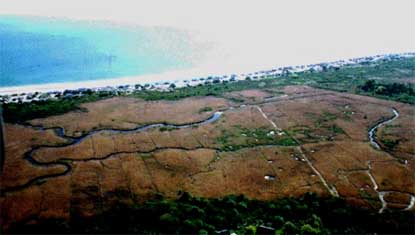Sagamore Marsh Restoration Project Underway

One of the largest wetland restoration projects ever undertaken in New England is currently underway. Congressman William D. Delahunt, the keynote speaker at the April groundbreaking ceremony, said the $1.8 million, 50-acre Sagamore Marsh restoration will "soon reclaim and revitalize an important habitat on Cape Cod."

Scheduled for completion in 2001, the Sagamore Marsh project will restore tidal flow to the site, returning it to salt marsh and estuarine habitat. Widening of the Cape Cod Canal more than 60 years ago restricted tidal flow to the salt marsh.
State, federal, and local officials, as well as corporate sponsors participated in the groundbreaking ceremony. Dr. Joseph A. Westphal, Assistant Secretary of the Army for Civil Works and Chair of Coastal America, the federal office that facilitated federal involvement in the project, noted the project's corporate sponsorship under a new public-private initiative.
The Corporate Wetlands Restoration Partnership, established in Massachusetts in 1999 by The Gillette Company, the Mass. Executive Office of Environmental Affairs (EOEA) and the U.S. Environmental Protection Agency (EPA), combines corporate contributions with federal and state funds to restore wetlands and other aquatic habitats, in conjunction with the Coastal America partnership.
Multiple groups are contributing financially, scientifically to the project
The Sagamore Marsh project is under the direction of the U.S. Army Corps of Engineers and the Massachusetts Executive Office of Environmental Affairs. The National Marine Fisheries Service, U.S. Fish and Wildlife Service, and the EPA have provided expert scientific analyses in support of this ecological restoration project.
Of the approximately $2 million project cost, the federal government is contributing about $1.5 million, with the remainder funded by the Massachusetts Department of Environmental Management.
Seventeen companies have joined the Massachusetts Corporate Wetlands Restoration Partnership, contributing more than $1 million. In January 2000, working with Coastal America, the Partnership expanded region-wide with the establishment of the New England Corporate Wetlands Restoration Partnership. Gillette is now working with Coastal America to launch the National Corporate Wetlands Restoration Partnership this spring.
A 70-year old culvert was unable to provide sufficient tidal flushing to maintain the marsh
Tidal flushing of the Sagamore Marsh was restricted in the mid-1930s when the Cape Cod Canal was widened and deepened, creating a fresh and brackish water system. Formerly, the Scusset River, which provided tidal flushing to Sagamore Marsh, flowed into Cape Cod Bay, north of the present canal's jetty. Accretion of material to the north of the jetty, along with the disposal of dredged material in the marsh, contributed to the reduction of tidal flows to the marsh. A 48-inch diameter culvert was constructed in the mid-1930s at the south end of the marsh to drain runoff from the marsh into the canal. The culvert was inadequate to provide sufficient tidal flushing to maintain the salt marsh, and the present level of tidal interchange is only able to support approximately 12 acres of salt marsh and estuarine habitat.
Since the reduction of tidal interchange, Sagamore Marsh has changed from an area which consisted predominantly salt marsh and estuarine habitat to an area that is dominated by relatively low-value common reed (Phragmites). If no future action is taken, it is expected that a large portion of Sagamore Marsh will continue to support Phragmites with limited ecological value. The benefits of increasing the area and productivity of estuarine habitat would not occur. In addition, the dense stand of Phragmites will remain a fire hazard, and will complicate efforts to control mosquitoes.
Various alternatives were examined to restore the salt marsh. The method providing the maximum project benefits calls for replacing the existing degraded 48-inch diameter reinforced concrete culverts beneath the Scusset Beach and the Cape Cod Canal service roads with two 6-foot high by 6-foot wide reinforced concrete box culverts under each road, installing electric sluice gates for primary flow control with manual backup flow control at the gates, deepening the man-made channel which extends 1,100 feet north into the marsh from the canal, and widening the man-made channel from an existing bottom width of 4-feet to 12-feet.
Northern Construction Service of Hingham, MA is working on the project; completion is scheduled for December 2000.
Edited by Tracy Fabre
